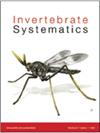综合分类学表明,并非所有的欧洲红蛙都是相同的:铁纹蛙,1977年(腹足目,异鳃目,蛙科)物种复合体,并描述了一个新属
IF 1.9
2区 生物学
Q3 EVOLUTIONARY BIOLOGY
引用次数: 0
摘要
摘要由于其体积小、形态隐蔽,类蛙是最难研究的海洋异鳃类动物之一,也是目前知之甚少的类群之一。直到最近,分子工具和系统发生学才首次用于研究系统学。1977年,在英国普利茅斯首次描述的极具魅力的欧洲红棕色物种Runcina ferroginea Kress,是这些蛞蝓分类学面临挑战的典范。由于R.ferroginea和Thompson于1980年描述的克罗地亚物种R.zavodniki之间的相似性,后者被认为是初级同义词。然而,分子系统发育学揭示了一个由四个物种组成的复合体的出现,该复合体被命名为R.ferroginea。通过综合方法,结合多基因座(COI、16S rRNA和组蛋白H3)分子系统发育学和形态解剖特征(身体的形状和颜色、拉杜拉、砂板和生殖系统),基于来自英国西南部和地中海中西部(西班牙、法国、意大利和克罗地亚)的标本,我们重新描述了R.ferroginea proper,并确认R.zavodniki是一个有效的物种。此外,还描述了两个新种,一个属于Runcina属(R.lupiaensis sp.nov.),另一个属于新属Pseudoruncina gen.nov.(Pseudoruncina marine gen.et sp.nov..)。ZooBank:urn:lsid:ZooBank.org/pub:2611EF7D-7762-40CE-BD04-B6D9AB70F2AA。本文章由计算机程序翻译,如有差异,请以英文原文为准。
Integrative taxonomy reveals that not all European reddish runcinids are the same: the case of the Runcina ferruginea Kress, 1977 (Gastropoda, Heterobranchia, Runcinida) species-complex, with the description of a new genus
ABSTRACT Owing to the small size and cryptic morphology, runcinids are among the most difficult marine heterobranchs to study and consequently one of the groups about which little is known. Only recently were molecular tools and phylogenetics first employed to study the systematics. The charismatic European reddish-brown species Runcina ferruginea Kress, 1977, first described from Plymouth, UK, is a paradigm of the challenges facing the taxonomy of these slugs. Due to similarities between R. ferruginea and the Croatian species R. zavodniki described by Thompson, 1980, the latter has been considered as a junior synonym. However, molecular phylogenetics revealed the occurrence of a complex of four species masked under the name R. ferruginea. Through an integrative approach, combining multi-locus (COI, 16S rRNA and histone H3) molecular phylogenetics and morpho-anatomical characters (shape and colouration of body, radula, gizzard plates and reproductive systems) based on specimens from south-western UK, and the central and western Mediterranean Sea (Spain, France, Italy and Croatia), we redescribe R. ferruginea proper and confirm R. zavodniki as a valid species. Also, two new species are described, one belonging to the genus Runcina (R. lupiaensis sp. nov.) and the other to the new genus Pseudoruncina gen. nov. (Pseudoruncina marinae gen. et sp. nov.). Our study exposes the occurrence of cryptic diversity among runcinids and stresses the need for additional work to understand the diversity of this group of minute molluscs. ZooBank: urn:lsid:zoobank.org:pub:2611EF7D-7762-40CE-BD04-B6D9AB70F2AA.
求助全文
通过发布文献求助,成功后即可免费获取论文全文。
去求助
来源期刊

Invertebrate Systematics
生物-动物学
CiteScore
4.30
自引率
9.10%
发文量
35
审稿时长
>12 weeks
期刊介绍:
Invertebrate Systematics (formerly known as Invertebrate Taxonomy) is an international journal publishing original and significant contributions on the systematics, phylogeny and biogeography of all invertebrate taxa. Articles in the journal provide comprehensive treatments of clearly defined taxonomic groups, often emphasising their biodiversity patterns and/or biological aspects. The journal also includes contributions on the systematics of selected species that are of particular conservation, economic, medical or veterinary importance.
Invertebrate Systematics is a vital resource globally for scientists, students, conservation biologists, environmental consultants and government policy advisors who are interested in terrestrial, freshwater and marine systems.
Invertebrate Systematics is published with the endorsement of the Commonwealth Scientific and Industrial Research Organisation (CSIRO) and the Australian Academy of Science.
 求助内容:
求助内容: 应助结果提醒方式:
应助结果提醒方式:


